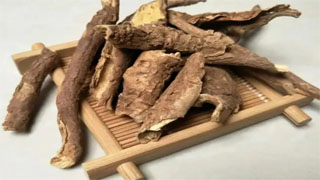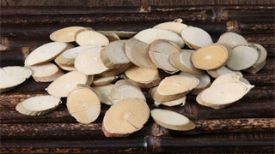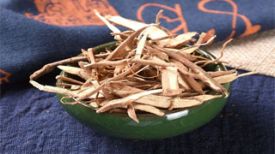
1. Alias
Beiwujiapi, Gangliupi, Xiangwujiapi.
2. Plant morphology
Deciduous creeping shrubs, up to 2 meters tall, all containing milk. The stem is deep purple red or gray brown, and the small branches are often paired, yellow brown or gray yellow, with fine stripes and light brown polka dot shaped protrusions on the skin holes. Leaves are opposite, with a lanceolate or elongated lanceolate shape, a gradually pointed tip, a wedge-shaped or rounded base, a full margin, dark green on top, glossy, and light green on the bottom, and a straight line along the leaf edge near the tip. Umbrella inflorescence, axillary, with 1-5 flowers, sepals deeply lobed, lobes ovate, corolla yellow green, deeply lobed, with a small white felt in the middle of the inner surface of the lobes, purple brown spots on the periphery, densely covered with white long hairs near the edge, 5 accessory corollas, 5 stamens, combined into a cone shape, with the pistil enclosed in it. Fruit pods.
3. Origin distribution
Born in sunny areas on mountain slopes, along roadsides, and by gullies. Distributed in Heilongjiang, Jilin, Liaoning, Inner Mongolia and other places.
4. Harvesting and processing
In spring and autumn, dig the roots, strike them while they are wet, peel off the root bark, remove the wood core, and dry them in the sun.
5. Characteristics of medicinal herbs
Mostly in the form of a single roll, occasionally in the form of double rolls, grooves, or irregular fragments, measuring 3-8 (~15) centimeters in length and 1-5 millimeters in thickness. The outer surface is earthy yellow, light brown to dark brown. Most of them have layered and peelable cork, with occasional lateral protruding skin holes. The inner surface is yellow white or light yellow brown, smooth, with fine longitudinal lines. Lightweight, brittle, easy to break, with a yellow white cross-section. It has a special rich aroma and a bitter taste.
6. Sexual Taste Returning to the Classics
Warm in nature, spicy and bitter in taste. Return to the liver meridian, kidney meridian, and heart meridian.
7. Effect and Function
Dispelling wind and dampness, strengthening muscles and bones, promoting urination. Belonging to the category of wind dampness dispelling drugs, it is a strong muscle and bone dispelling medicine.
8. Clinical application
Take 5-10 grams of decoction orally; Soak in wine or pill powder. Treat rheumatism, muscle and bone pain, edema, oliguria, palpitations, shortness of breath, wind cold dampness, and soreness of the waist and knees.
9. Pharmacological research
Has strong cardiac and pressor effects, but cannot counteract the central inhibitory effect of barbiturates; It has the effects of enhancing respiratory system function, anti-cancer, anticholinesterase, anti radiation, insecticidal, etc. The ethanol extract enhances heart contraction in both in vivo and ex vivo frog hearts, as well as in vivo cat hearts and ex vivo cat heart lung devices. High doses cause the heart to stop during systole; One or multiple doses of paeoniflorin can increase the levels of adrenal cortex and cholesterol, as well as increase the weight of the adrenal gland; Gangliu tincture exhibits central excitation (in toads and mice); Subcutaneous injection of ether extract after acidification of alcohol extract reduces cat's spontaneous activity and slows down breathing; Chloroform methanol elution has inhibitory effects on S-O sarcoma in mice. Toxicity: Excessive use of cardiac glycosides can cause poisoning in animals and humans. After poisoning, there may be a sudden increase in blood pressure, enhanced cardiac contractility, arrhythmia, and even myocardial fibrillation leading to death, accompanied by vomiting.
10. Chemical composition
Containing steroidal glycosides, naringin, free pregnenolic compounds, etc. It also contains components such as rutin G, rutin K, rutin Hl, rutin H2, naringin A, naringin B, naringin C, naringin Canadian, 4-methoxysalicylaldehyde, etc.
11. Usage taboos
This product is toxic and should not be taken in excess. Cannot be used as a substitute for the bark of the Araliaceae plant. Those with yin deficiency and excessive fire should take it with caution.
12. Compatibility prescription
① Treatment for rheumatoid arthritis and joint spasm pain: 15 grams each of Xiangjiapi, Chuanshanlong, and Baixianpi. Soak in Baijiu for 24 hours. Take 10 milliliters daily. (Selected Chinese Herbal Medicines from Shaanxi, Gansu, Ningxia, and Qinghai)
② Treatment for edema and poor urination: 9 grams each of Xiangjiapi, Chenpi, Ginger Peel, Poria cocos Peel, and Dabaopi. Boil it in water. (Selected Chinese Herbal Medicines from Shaanxi, Gansu, Ningxia, and Qinghai)
③ Treatment of scrotal edema: 9 grams of Xiangjiapi and 30 grams of Xiantou. Boil it in water. (Shandong Herbal Medicine Handbook)
④ Treat skin and genital itching: add an appropriate amount of fragrant skin. Wash the soup outside. (Qingdao Herbal Medicine Handbook)
⊙ The content of the article is for clinical reference only. Non TCM professionals are not allowed to test drugs.


